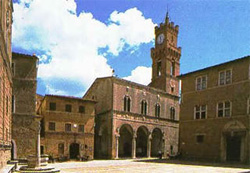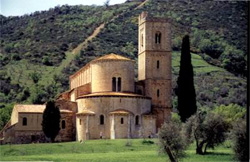
 Pienza owes its name and fame to Enea Silvio Piccolomini, who became famous as Pius II. Known in the Early Middle Age as Corsignano, it was a fortress in the province of Senese, well-known because mentioned in a tale by Giovanni Boccaccio.
Pienza owes its name and fame to Enea Silvio Piccolomini, who became famous as Pius II. Known in the Early Middle Age as Corsignano, it was a fortress in the province of Senese, well-known because mentioned in a tale by Giovanni Boccaccio.
Most of its beautiful architecture was accomplished by Pope Pius II between 1459 and 1462, who called Bernardo Rossellino, one of the most famous architects of that age, to work in Pienza, thus making an exceptional example of the architecture and town-planning of the 15th century. Its magic centre is the well-known trapezoidal square where you can find the Cathedral, Corso Rossellino, Palazzo Piccolomi and Palazzo Borgia.
The cathedral in the Renaissance style, has a bright interior, made up of a nave and three aisles, equal in size. Rossellino’s masterpiece is also the wonderful Renaissance Palazzo Piccolomini, with an elegant yard and hanging garden. The small town preserves other noteworthy buildings of the 15th century (the Town Hall and the Bishop’s Palace), not to mention Church San Francesco (13th century) and Pieve di Corsignano (11th – 13th century).
 Many Etruscan and Roman traces were found on the Monticchiello hill.
Many Etruscan and Roman traces were found on the Monticchiello hill.
The Monticchiello community was subject to the administration of the San Salvatore abbey in the Amiata area, already in the 8th century. The castle passed on to the Aldobrandi and Forteguerri family and then to the Church, which enfeoffed it to the Teutonic Knights, until the hegemony of the Municipality of Siena prevailed in Val d’Orcia.
Monticchiello became a frontier fortress under Balzana. Charles V managed in conquering it in 1553, but the inhabitants’ relentless resistance remained famous for a long time. Up to 1778, the small municipality administered itself by means of its statues. During World War Two, on 6th April 1944, Monticchiello was the stage of a dramatic battle, at the end of which the forces of local resistance prevailed.
The town is still preserving the sober traits of medieval fortresses, considerably clashing with the Renaissance picture offered by Pienza. The sturdy circle of walls and the tower rising up on the hill are the signs of the intense past of the village, a bulwark of the defensive system of the Republic of Siena.
 It is a very old village, probably of Etruscan origin. It is placed on a hill separating the Asso valley from the Orcia valley. Noteworthy is the Collegiata. It has got three portals outside: a Romanesque one made of sandstone and travertine, the second one built in 1288 with remarkable sculptures and the third one in a Romanesque-Gothic style.
It is a very old village, probably of Etruscan origin. It is placed on a hill separating the Asso valley from the Orcia valley. Noteworthy is the Collegiata. It has got three portals outside: a Romanesque one made of sandstone and travertine, the second one built in 1288 with remarkable sculptures and the third one in a Romanesque-Gothic style.
Church San Francesco – placed on the main square of the town – has got many Gothic elements inside. Horti Leonini – accomplished around 1580 by Diomede Leoni – is a wonderful example of garden in the Italian style. On entering the garden – you can access from the entrance between the castle walls and the main square of the town, you can enjoy a wide perspective, surrounded by beds of box-trees enhancing geometric shapes. Against the background of the scene are placed thick age-old holm oaks, among which emerges a travertine staircase giving access to the upper floor.
Santa Maria Assunta, a Romanesque church known since 1017, is a wonderful Romanesque small church with one single nave, in which the light is just filtering through mullioned windows with one light.
Ospedale della Scala, placed in front of Santa Maria Assunta, gave the pilgrims and travellers along Via Francigena hospitality. Built in the 13th century, it is currently preserving a yard, in the middle of which there is a well of the 16th century.
 The name of this old village comes from Vignoni, a castle already known in the 11th century - whose traces dominate the rise above the village - and from the thermal waters used since the Roman age, as it is testified by many archaeological finds in the Chigi di Siena collection, the National Archaeological Museum.
The name of this old village comes from Vignoni, a castle already known in the 11th century - whose traces dominate the rise above the village - and from the thermal waters used since the Roman age, as it is testified by many archaeological finds in the Chigi di Siena collection, the National Archaeological Museum.
The village developed on an esplanade, in the middle between the Vignoni hill and the steep gorge formed by the Orcia river, around a large rectangular pool, into which waters gush out. This element, which is the future generator of the village establishment and still the centre of the village, represents a clear reference to some aspects, typical of Roman thermal establishments.
Dwelling-places, inns and, then, Church San Giovanni Battista were built around the pool. Starting from the pool, after having crossed a portico-bridge, waters reached the baths to feed a series of mills on a steep edge degrading to the river you can visit at present.
Nowadays, Bagno Vignoni is well-known and appreciated all over the world as a valuable thermal place, in a landscape district of impressive beauty, in the heart of the Val d’Orcia Artistic, Natural and Cultural Park.
 Montepulciano is built along a narrow crest of limestone surrounded by a circle of walls and by fortifications.
Montepulciano is built along a narrow crest of limestone surrounded by a circle of walls and by fortifications.
The village is mainly known for the impressiveness of its Renaissance palaces, the elegant beauty of its churches and the Nobile wine, one of the Tuscan wines best appreciated on an international level.
The urban centre develops along a road climbing along the hill and reaching the main square, Piazza Grande, on its top.
The nice Madonna di San Biagio temple beneath the circle of walls is made of pearly white travertine.
Church Sant'Agostino was built by Michelozzo in 1427 with a sculptured elaborate portal representing the Virgin and the child close to San Giovanni and Sant’Agostino.
Palazzo Tarugi is an impressive palace of the 16th century, next to the Town Hall and it is one of the most beautiful examples of civil architecture of the 16th century.
The Cathedral was built by Ippolito Scalsa between 1592 and 1630. The front is unfinished and has no marble coating.
 Town placed between Val d'Orcia and the Eastern slope of the Paglia valley. Radicofani’s built-up area is of Roman origin and it is perfectly preserved in its Middle Age shapes.
Town placed between Val d'Orcia and the Eastern slope of the Paglia valley. Radicofani’s built-up area is of Roman origin and it is perfectly preserved in its Middle Age shapes.
The town is characterised by the presence of the fort towering about the Paglia valley, along which was winding Via Francigena. The way soon moved from the bottom of the valley to Radicofoni. The fortress built in the Early Middle Age and then enlarged several times acquired a considerable military importance, besides representing a compulsory halt for travellers and pilgrims coming from the north to admire the romantic panorama, consisting of the powerful fortress in ruins, full of its historical and literary memories focussing on the figure of one of its old and legendary lord, Ghino di Tacco, a cruel, but cultured and surprising man-at-arms, whose deeds are described by Dante and Boccaccio.
Palazzo Pretorio, the current Town Hall, is located in the upper part of the town. Built in 1255, it has got the arms of the podestas at the time of the Republic of Siena. Going down the main road, you will find Church S. Agata, the Friar Minor Conventuals’ former cloister. Apostle Peter’s parish church in the Romanesque style of the 13th century is located on the square in front. Ghino di Tacco’s basalt stone statue is erected in the public gardens adjacent to the place. "La Posta", the grand Medici villa, is located in the lower part of the town..
 One of the most important “route of faith” in Europe winds across the hills and cypresses of Val d’Orcia. Extremely fascinating churches and abbeys were erected around it in the Middle Age.
One of the most important “route of faith” in Europe winds across the hills and cypresses of Val d’Orcia. Extremely fascinating churches and abbeys were erected around it in the Middle Age.
It is impossible to understand the flourishing of religious monuments in Val d’Orcia without considering Francigena and its famous travellers.
According to a tradition not confirmed by historians, Charlemagne received San Sebastiano’s and Sant'Antimo relics from Pope Hadrian I between 774 and 781 and founded one of the most important monasteries in Tuscany in their honour. Even if the king of the Franks (and the future emperor) did not stop in Val d’Orcia, it is sure that Sant’Antimo abbey had already been officiated in 814.
Its shapes recalling those of the great Romanesque churches in France are a further evidence of the influence the route had on these hills.
 It is made known by Brunello, one of the best red wines all over the world. But Montalcino is also a wonderful town of art dominating 3,000 hectares of vineyards (1,500 of which for Brunello), which gave it celebrity and richness.
It is made known by Brunello, one of the best red wines all over the world. But Montalcino is also a wonderful town of art dominating 3,000 hectares of vineyards (1,500 of which for Brunello), which gave it celebrity and richness.
Lying between the Ombrone and Orcia basins, the centre is supervised from the fortress built in 1361 to seal the addition of Montalcino to the Siena possessions.
Not only the fortress, but also the slender town of Palazzo Comunale, built between the 13th and 14th century, is the symbol of Montalcino. Piazza del Popolo and the Gothic Loggia are located at the bottom.
 Via Francigena is the route of a pilgrimage from Canterbury to Rome and it represented one of the most important European ways of communication in the Middle Age.
Via Francigena is the route of a pilgrimage from Canterbury to Rome and it represented one of the most important European ways of communication in the Middle Age.
In the Middle Age, the pilgrimage to Rome to visit Apostle Peter’s tomb was one of the three peregrinationes maiores, together with the Holy Land and Santiago di Compostela. In most cases, the pilgrims followed the Roman consular routes. The pilgrims coming above all from the land of the Franks in the Post-Carolingian age began to cross the Alps and to enter Italy. The best-known route crossed the Monginevro pass, thus assigning the route to Rome the name Francigena, i.e. coming from the land of the Franks. As a consequence, the route became part of a wide network of European roads and ways joining all the greatest places of spirituality at the time of pilgrimage.
The territory is still showing some traces of this passage, which has deeply structured the settlements and traditions of the places the pilgrims were used to go through.